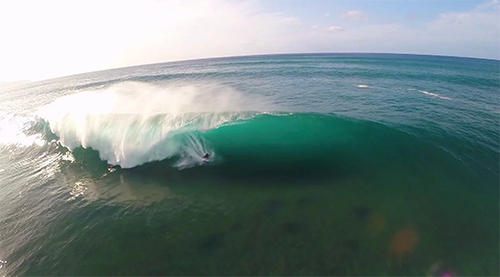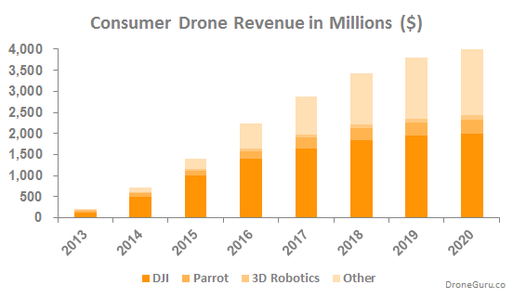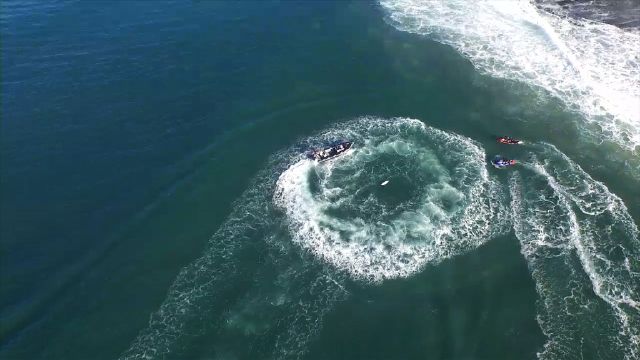Drone redux
 Last month Intel Corp. announced they were pouring $60 million into Yuneec, a Shanghai-based drone and aerospace company. Intel is the world's largest producer of computer chips and its entry into the drone industry marks a significant shift in the drone industry. Said Intel's CEO Brian Krzanich following the investment into Yuneec: “We’ve got drones on our road map that are going to truly change the world and revolutionise the drone industry.”
Last month Intel Corp. announced they were pouring $60 million into Yuneec, a Shanghai-based drone and aerospace company. Intel is the world's largest producer of computer chips and its entry into the drone industry marks a significant shift in the drone industry. Said Intel's CEO Brian Krzanich following the investment into Yuneec: “We’ve got drones on our road map that are going to truly change the world and revolutionise the drone industry.”
In January last year Swellnet ran an article about the then-burgeoning area of drone surf photography. Just a month previous a young Hawaiian drone operator, Eric Sterman, captured the finest footage from the 2013 Pipeline Masters. For Sterman, who first saw a drone six months earlier, it was one of his first flights over the North Shore. The footage he captured, especially that of Kelly Slater dropping into an inside Pipe double up, was beguiling. It quickly clocked 200,000 views on Vimeo. Not only was it dazzling, it was also the first time the aerial view of Pipe had been shown to the wider world - save those few times Warren Bolster flew a helicopter overhead back in the 80s.
What happened next is indicative of the media saturated world we live. Within months of Sterman's footage being seen, surf photographers everywhere began buying their own kits and experimenting, the results celebrated in an overwhelming cavalcade of web clips. It'd be hyperbolic to say that drones were everywhere, but the evidence of them sure made it seem that way. And then the predictable backlash began; the overuse of the aerial angle not missed by those who frequent website comment threads.
Drone photography went from a novelty to a cliché in just 12 months.
 Yet judging by Intel's recent entry into the market it'd be incorrect to label drones as a passing fad. In May this year the company that's widely considered to be the market leader, DJI, received $75 million in funding from a venture capital firm. Another, 3D Robotics, raised $64 million this year. Meanwhile the drone industry has grown from less than $250 million in 2013 – the year Eric Sterman first laid eyes on one – to an estimated $1.5 billion this year. And this is before GoPro announced its planned entry into the drone market, set for early next year. By 2020 the drone industry will be an estimated $4 billion. Clearly the surfing world better get used to seeing the view from up there.
Yet judging by Intel's recent entry into the market it'd be incorrect to label drones as a passing fad. In May this year the company that's widely considered to be the market leader, DJI, received $75 million in funding from a venture capital firm. Another, 3D Robotics, raised $64 million this year. Meanwhile the drone industry has grown from less than $250 million in 2013 – the year Eric Sterman first laid eyes on one – to an estimated $1.5 billion this year. And this is before GoPro announced its planned entry into the drone market, set for early next year. By 2020 the drone industry will be an estimated $4 billion. Clearly the surfing world better get used to seeing the view from up there.
“Drone photography has enormous potential that’s only really beginning to be tapped,” says photographer Ed Sloane. Sloane has used drones for commercial photography both within the surfing world and without. “The hype might die down but things are only getting started in regard to their cost-benefit for so many applications.”
Regarding the hype, Sloane says drone footage is “just another tool to tell stories.” He believes the aerial angle should be mixed with other angles and views.
“Like the fisheye angle it’s done to death...[but] with cameras getting smaller and lighter hopefully we can move away from the wide-angle look. In a creative sense drones will continue to offer cheap, unique angles.”
Sloane is understandably coy about his ideas for drone photography, suffice to say drone photography “hasn't yet reached it's potential in my opinion.”
Recently Eric Sterman handed his drone, fitted with a camera, to Jamie O'Brien as he towed into Teahupoo. O'Brien pulled into the barrel, all caught on camera in what's become conventional surf footage, but then he let go of the drone upon exit, allowing the clip to end with an overarching shot of the Teahupoo reef. The idea was borrowed from the snowboard world where it's been used to great effect but it shows that with a bit of imagination there's still plenty of fresh ideas to discover.
*****
In Swellnet's original article we spoke to Dave Prodan, the World Surf League's (WSL) VP of Media, who admitted that he'd seen Eric Sterman's footage of the Pipe Masters and the result had generated lots of "internal discussions" at surfing's peak body. In April 2014, just a few months after Sterman's Pipe video was published, the WSL used drone footage in the webcast for the Rip Curl Pro at Bells Beach. Similar footage has been used intermittently at WSL events since then.
Before they began using drones, the WSL was wary of distracting surfers while competing. However, in a recent discussion with Swellnet Dave claims that he's had nothing but “positive feedback from the athletes with regard to the new angle now accessible for viewing.”
Splicing drone footage into a live webcast is very new technology and as such it isn't without its problems. “Chief amongst them is limited flight time,” says Prodan. “That said, the technology is evolving fairly rapidly and we're keen to take advantage of it.” Says Dave, “Expect an increase in the usage of drones in the future.”
 The last issue pertaining to the WSL is safety, something high on the agenda since this year's Jeffrey's Bay Pro. Following that incident numerous drone operators claimed on social media that if there was a surveillance drone in place the shark would've been spotted earlier and preventative action taken. Dave admits the topic has been discussed but refuses to be drawn on the outcome.
The last issue pertaining to the WSL is safety, something high on the agenda since this year's Jeffrey's Bay Pro. Following that incident numerous drone operators claimed on social media that if there was a surveillance drone in place the shark would've been spotted earlier and preventative action taken. Dave admits the topic has been discussed but refuses to be drawn on the outcome.
“All mechanisms of the sport are being considered with regards to safety. Drones, as potentially enhancing the surveillance mechanism at some venues, have been discussed.”
*****
In 2002 Australia became the first country to write legislation for drones, or RPAs (Remotely Piloted Aircraft) as they're known here. Peter Gibson is the spokesperson for Australia's Civil Aviation Safety Authority (CASA) and admits that “it's hard to write enforceable legislation when we don't know where the technology will be in a few years.” However, unlike some other countries, Australia has done well to predict where it's heading in the future.
Early last year there were 77 commercial operators in Australia, now there's nearly 300. The uses those operators are being put to have expanded widely: police work, fire brigades, mining, surveying, and many forms of agriculture, to name a few.
CASA has been working on regulations that will relax the current laws for commercial operators. These changes in law match the forecast increase in demand. Most importantly, they'll include the introduction of a new below two kilogram commercial drone category. This means operators with a drone weighing less than two kilograms – which most popular models fitted with a GoPro do - would not need a certificate. They would, however, need to register with CASA and operate within the law, though this change provides latitude to operators who straddle the fuzzy line between enthusiast and professional. Think of a part-time surf photographer who uploads footage to YouTube that becomes sought after by a company. It's not an unusual scenario but under previous iterations of the law, said photographer would've broken the law if he'd sold the footage.
The new rule changes will come into effect later this year or early next, but you won't find Peter Gibson resting on his laurels. CASA are going to “review all of the drone and RPA rules in the light of new technology and new uses and that will happen starting next year. As Peter Gibson puts is, “The growth in this sector of aviation is not going to slow anytime soon.”


Comments
These laws thru CASA have to be reinforced harder for everyone to fly drones. IE extensive training, nationally accredited tickets, further training every year or so etc
I remember Trippergreenfeet was talking about this awhile back!
IMO when these guru photographers are flying an object around people, there should be procedures in place, as this is an object that can or could fall from the sky from mechanical or human era and kill someone, whether it be 1kg or 10,000kg...?
Hey no disrespect to all the great photographers out there, but usually you just click a button to take a photo or video, not fly an object that could kill some innocent person who is having a good time?
Gotta admit I feel some kind of visceral antipathy verging on hatred of drones when I see them around.
Not sure whether it's due to that feeling now that we are under constant surveillance and having some buzzy little mechanical fly zooming around is the physical manifestation of that modern reality.
This footage did give me some hope.
dont worry, a tin foil hat should sort out those feelings of paranoia
I thought a sling shot might work better
Classic footage.
x2 FR76;)
Invest now, get in on ground level!
Yep, another annoying buzz in the surf environment ...
FR I take it Drone shark surveillance isn't considered a favourable option down your way
Gary G, are you using drones these days to shoot your outdoor porno scenes??
haha.
No serious now.. ;)
My work I partake in requires certificates and time ( I.E. hours ) that can only be signed off from an accredited, experienced person.
This type of accreditation has to be regulated with drone users IMO.
Training courses, maybe level 1, level 2 and advanced level 3 with every level requiring a certain amount of hours to become an experienced drone operator...!
Each level should be diverse, lets say to fly a drone over forest or vast land with no humans involved, Level 1....!
Level 2 flying round monkeys..... Animals.
Level 3 flying around humans.... I mean Monkeys;)....?
IMO a serious accident will happen soon which will spark this conformity.
How's this new drone that works in the air and underwater!
http://www.vocativ.com/news/259629/this-awesome-drone-can-conquer-both-s...
Ben, here's a safe one - Fleye drone.
All drones in the US which weigh more than 250grams, after feb 2016 need to be registered and carry reg numbers...
I can see the WSL deploying something similar to this next year...
Eagles as drone defenders: "Mostly, the most crazy ideas work the best". nyti.ms/1WVbDam